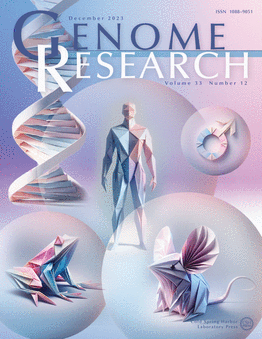利用PlatinumCRISPr进行结构优化的sgRNA选择,实现Cas9基因敲除的高效产生
IF 6.2
2区 生物学
Q1 BIOCHEMISTRY & MOLECULAR BIOLOGY
引用次数: 0
摘要
单导RNA (sgRNA)指导Cas9核酸酶进行双链DNA的基因特异性切割。高Cas9活性是高效基因编辑产生基因缺失和同源重组基因替代的必要条件。然而,在人类细胞培养筛选或模式生物中,超过一半的随机选择的sgRNA序列的切割效率低于50%。我们使用体外实验来确定最大sgRNA活性的内在分子参数,包括sgRNA的正确折叠和Cas9的结构信息。通过对10多个数据集的比较,我们发现sgRNA设计的主要制约因素来自sgRNA的二级结构缺陷、种子区序列上下文、GC上下文和有害基序,但我们也发现不同的预测工具在应用于不同的数据集时存在相当大的差异。为了帮助选择高效的sgRNA,我们开发了基于web的PlatinumCRISPr,这是一个sgRNA设计工具,用于评估碱基配对和序列组成参数,以优化设计用于Cas9基因组编辑的高效sgRNA。我们使用该工具选择sgRNAs来有效地在果蝇Ythdc1和Ythdf中产生基因缺失,这些缺失与mRNA中的N6甲基化腺苷(m6A)结合。然而,我们发现,用sgrna和Cas9产生小的缺失会导致基因组中其他地方缺失的DNA片段异位重新插入。这些插入可以通过标准的基因重组和染色体交换去除。这些关于sgRNA设计和CRISPR-Cas9基因组编辑机制的新见解促进了该技术在人类中更安全应用的有效利用。本文章由计算机程序翻译,如有差异,请以英文原文为准。
Structure-optimized sgRNA selection with PlatinumCRISPr for efficient Cas9 generation of knockouts
A single guide RNA (sgRNA) directs Cas9 nuclease for gene-specific scission of double-stranded DNA. High Cas9 activity is essential for efficient gene editing to generate gene deletions and gene replacements by homologous recombination. However, cleavage efficiency is below 50% for more than half of randomly selected sgRNA sequences in human cell culture screens or model organisms. We used in vitro assays to determine intrinsic molecular parameters for maximal sgRNA activity including correct folding of sgRNAs and Cas9 structural information. From the comparison of over 10 data sets, we find major constraints in sgRNA design originating from defective secondary structure of the sgRNA, sequence context of the seed region, GC context, and detrimental motifs, but we also find considerable variation among different prediction tools when applied to different data sets. To aid selection of efficient sgRNAs, we developed web-based PlatinumCRISPr, an sgRNA design tool to evaluate base-pairing and sequence composition parameters for optimal design of highly efficient sgRNAs for Cas9 genome editing. We applied this tool to select sgRNAs to efficiently generate gene deletions in Drosophila Ythdc1 and Ythdf, that bind to N6 methylated adenosines (m6A) in mRNA. However, we discovered that generating small deletions with sgRNAs and Cas9 leads to ectopic reinsertion of the deleted DNA fragment elsewhere in the genome. These insertions can be removed by standard genetic recombination and chromosome exchange. These new insights into sgRNA design and the mechanisms of CRISPR–Cas9 genome editing advance the efficient use of this technique for safer applications in humans.
求助全文
通过发布文献求助,成功后即可免费获取论文全文。
去求助
来源期刊

Genome research
生物-生化与分子生物学
CiteScore
12.40
自引率
1.40%
发文量
140
审稿时长
6 months
期刊介绍:
Launched in 1995, Genome Research is an international, continuously published, peer-reviewed journal that focuses on research that provides novel insights into the genome biology of all organisms, including advances in genomic medicine.
Among the topics considered by the journal are genome structure and function, comparative genomics, molecular evolution, genome-scale quantitative and population genetics, proteomics, epigenomics, and systems biology. The journal also features exciting gene discoveries and reports of cutting-edge computational biology and high-throughput methodologies.
New data in these areas are published as research papers, or methods and resource reports that provide novel information on technologies or tools that will be of interest to a broad readership. Complete data sets are presented electronically on the journal''s web site where appropriate. The journal also provides Reviews, Perspectives, and Insight/Outlook articles, which present commentary on the latest advances published both here and elsewhere, placing such progress in its broader biological context.
 求助内容:
求助内容: 应助结果提醒方式:
应助结果提醒方式:


